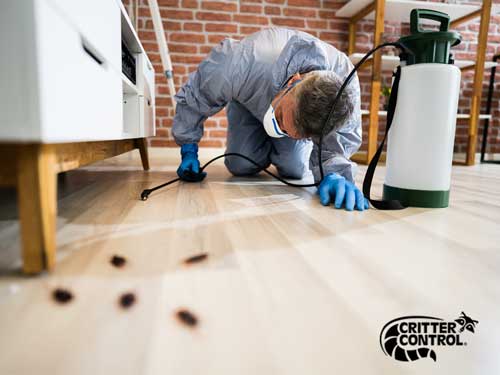A1 Bed Bug Exterminator Charlotte - Reliable and Inexpensive Services
A1 Bed Bug Exterminator Charlotte - Reliable and Inexpensive Services
Blog Article
Bed Bug Therapy Malfunction: Comparing Chemical Vs. Non-Chemical Solutions
In the world of parasite control, especially when taking care of the persistent concern of bed insects, the option in between chemical and non-chemical therapy services can be a crucial one. Both techniques offer unique benefits and downsides, influencing variables such as efficiency, safety and security considerations, and general price. By examining the nuanced details of each technique, a more clear understanding of which course to seek in addressing a bed bug problem can be acquired.
Efficiency of Chemical Therapies
Chemical treatments for bed pest invasions have been widely acknowledged for their quick and potent efficacy in eradicating these pests. When taking into consideration the performance of chemical therapies, it is critical to understand that they can provide a quick and comprehensive service to a bed bug trouble.
In addition, chemical treatments have the advantage of using residual impacts, meaning that they can proceed to eliminate bed pests also after the initial application. This residual action is especially helpful in combating any type of potential re-infestations. Furthermore, the rapid activity of chemical treatments can bring alleviation to individuals dealing with severe bed insect invasions, enabling them to gain back control of their living rooms promptly.
Safety And Security Interest In Chemical Solutions
One important element that requires mindful factor to consider when utilizing chemical remedies for bed insect treatment is ensuring the security of occupants and the setting. Exposure to particular chemicals utilized in bed pest treatments can lead to respiratory system problems, skin irritation, or various other adverse responses, particularly in people with pre-existing conditions or level of sensitivities.
In addition, the ecological effect of chemical solutions is an additional considerable consideration. Some chemicals utilized in bed pest therapies may be harmful to helpful bugs, wild animals, and communities if they seep into the dirt or water supply. It is vital to make use of chemical therapies deliberately, complying with security standards, and thinking about much less hazardous alternatives to minimize these risks and guarantee the efficient and risk-free management of bed bug invasions.
Advantages of Non-Chemical Strategies
Considering the prospective safety and security issues and ecological impact linked with chemical services for bed pest treatment, exploring non-chemical strategies provides a promising choice with several unique advantages. Non-chemical treatments are ecologically friendly, as they do not add to air or water pollution, making them a lasting selection for bug control.
Additionally, non-chemical services can be effective in targeting bed pests, consisting of hard-to-reach locations where chemical therapies may not permeate - A1 bed bug exterminator charlotte. Approaches such as warm therapy, vacuuming, vapor cleansing, and cushion coverings offer complete eradication without the use of dangerous chemicals.
Limitations of Non-Chemical Treatments

Additionally, non-chemical treatments frequently call for several applications to attain successful removal. This can be lengthy and might not always assure full elimination of all bed insects and their eggs, especially in surprise or hard-to-reach locations.
Furthermore, the success of non-chemical therapies greatly relies upon correct execution and thoroughness, which can be testing for people without specialist experience. Inadequate application of non-chemical approaches may lead to incomplete removal, causing persistent invasions and the requirement for additional therapies.
Therefore, while non-chemical therapies have their benefits, it is necessary to acknowledge these limitations and consider them when figuring out the most reliable technique for handling bed insect invasions.
Expense Contrast: Chemical Vs. Non-Chemical Options
Given the restrictions connected with non-chemical treatments, an essential aspect to assess in the context of bed pest monitoring is the cost comparison between chemical and non-chemical alternatives. Chemical therapies normally involve the application of pesticides by professionals, which can vary from $250 to $900 per area, depending on the severity of the problem and the dimension of the area to be dealt with. On the other hand, non-chemical therapies like warm treatment or heavy steam can be a lot more pricey, with expenses ranging from $1,000 to $6,000 for a whole home. While the initial cost of chemical treatments may seem lower, numerous therapies might be called for to completely get rid of the invasion, possibly enhancing the overall price. On the various other hand, non-chemical alternatives might offer an extra green and sustainable option, although they can be cost-prohibitive for some individuals. Inevitably, when thinking about the price of bed pest therapy options, it is important to evaluate the upfront costs versus the performance and long-term sustainability of the picked go to the website approach.
Conclusion

Thinking about the possible safety and security issues and environmental impact associated with chemical services for bed pest treatment, checking out non-chemical techniques offers an encouraging alternative with a number of unique benefits.Offered the constraints linked with non-chemical treatments, an important facet to review in the context of bed insect monitoring is the expense contrast in between chemical and non-chemical choices. In contrast, non-chemical treatments like warm treatment or vapor can be extra costly, with expenses varying from $1,000 to $6,000 for a whole home. While the preliminary expense of chemical therapies may seem lower, numerous therapies may be needed to fully get rid of the problem, possibly boosting the overall price.In conclusion, when contrasting chemical and non-chemical bed bug treatment alternatives, it is essential to consider effectiveness, security, advantages, constraints, and price.
Report this page